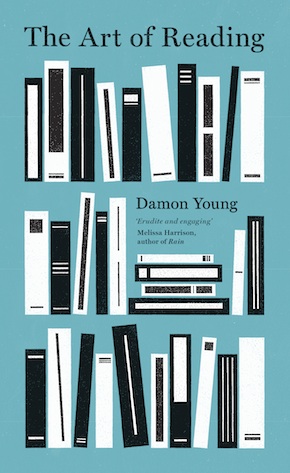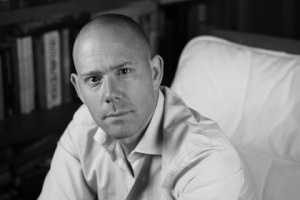A biblical paradise
by Mika Provata-Carlone
“An intimately conspiratorial book – erudite, surprising and persuasive.” Henry Hitchings
An impish dog playing tricks on his mistress brings about a meeting that will change the life of a monarch. Or so goes the story in Alan Bennett’s The Uncommon Reader, where a corgi-chasing Elizabeth II runs into a travelling library. The rest is a journey into a world of enchantment, discipline, determination, revelation. What is the good of reading? The passing of time? Edification? Cultural superiority? Wisdom? Or perhaps escape? “At the risk of sounding like a piece of steak, they tenderise one,” comes the indomitable answer of the British Crown.
For many of us, there has been such a corgi moment in our lives: a serendipitous encounter with a book that marks a turning point, a beginning, a greater clarity and focus of vision and a higher degree of sensitivity and feeling. For books, too, according to Borges, there are equally oracular meetings at the crossroads of shelves. A book is not a book without a reader, he would say, declaring even that “I had always imagined Paradise as a kind of library.” The biblical traced back to the biblos, biblion, bible…
Bibliophiles will relish Damon Young’s The Art of Reading, a hypnotic, erudite and riveting analysis of why we lose and find ourselves in the pages of books; of how to read, what it means to be a reader, the layers of consciousness involved in the act of approaching the written word, the enunciated thought, the imagined rendered real – for a moment that will often last an eternity. “Holmes was my first literary world,” begins Young. “This archaic lump of text helped me feel special. I was more clever, said the serious serif font, than the other 11-year-olds; more intellectually brave, said the ornamental binding, than my teachers.” Above all, it was “a kind of existential dress-up – an adult I tried on for size.” Yet what Young really got out of Conan Doyle’s tome was “freedom: the charisma of an independent mind [and] schooling in the exertion of my psyche… I first became aware of myself as something powerful: a reader.”
This ab initio declaration of intent sets the tone and magnitude of The Art of Reading. It is an almost epic journey across bookshelves and across time, an exploration of changing attitudes to textuality, readership, the very purpose of writing. Books, as Proust has told us, “are the only calendars we have kept of days that have vanished.” This, however, is no romantic foray into nostalgia. Young bares all as he allows us to see the figures in the carpet of his intellectual universe. Barring a playful flirtation with science fiction (the daredevil, saga kind), his true affections lie in Plato and Aristotle, Nietzsche and David Hume, John Dewy, Alfred North Whitehead and Parmenides, Virginia Woolf, Henry James, Kazantzakis, Yourcenar and Mallarmé. He feels strongly the seduction of Foucault, Augustine, Derrida, Heidegger and Barthes, Sartre and Borges, yet he also sees their opium-like effect on a clear mind: The Art of Reading is a “reply to [their] repression – a reminder of the reader’s power to realise worlds… Reading is always a meeting of two liberties: the artist’s and the audience’s.”
The Art of Reading contains radical distinctions: between curiosity and nosiness or gossip; between reading and writing and narcissism; between pleasure and the consumption of the passing hours.”
Reading is useful, enriching and enhancing, as well as a journey without a destination, intellectual, even erotic. Young knows how to be admiring even when critical, how to be selective and yet weave an extraordinary fabric of connections, allusions, possible paths of wandering and wonder, and especially opportunities for vicarious friendships of the mind. He possesses a talent for engrossing communication, sketching out sparkling portraits of literary ghosts whose presence is vital and real. We see writers in their own relationship to books and to reading, as well as towards writing. “I prefer rereading to reading, since when you reread, you are delving down,” was Borges’ mantra, and it seems also to be Young’s own. At the same time, he will criticise Borges for what Updike called “fervent narrowness”, and the precision of The Art of Reading, the lucidity of its syllogism and the pureness of its passion for words, stories, lives, minds make our engagement with the book an act of freedom, as well as succeeding in close affinity and attachment.
The Art of Reading contains radical distinctions: between curiosity and nosiness or gossip; between reading and writing and narcissism; between pleasure and the consumption of the passing hours. Reading emerges unblushingly as a qualitative, not quantitative enterprise, which means that Young never shirks from defining precise criteria of inclusion and exclusion, valorisation and rejection, of excellence and mere mediocrity. He has a thrill for Greek etymology, and not only Greek philosophy, as for example for the word ‘idiot’: not merely a fool but someone who is “privative and egocentric”. Young recognises humility as part and parcel of proper reading.
The book is full of lightness and light, a delicately alluring eloquence and a natural pace that makes the reader follow wherever one is taken. It is a perfect book for a mellow summer’s evening, a lazy Sunday morning, a sufficiently permissive flight, or a winter’s night. At the same time, The Art of Reading is intended for the philosophic reader or the reading philosopher, an absolute feast of ideas but also of journeys through the possibilities and infinite pleasures of thought itself. Books, Young seems to say, matter because thought matters, they create a community of thinkers, of human beings yearning for the exchange of words, experiences, perspectives, feelings, dreams and tragedies. Books and their readers seek meaning and intimacy¸ relationships and the relating of stories. As tales change hands, as pages are perused by different eyes, extraordinary transformations take place. As Zadie Smith wrote, “there is a joy in getting someone to hand us their butterfly, so we can spend twenty pages making the case for its being our giraffe.”
Old-fashioned schoolbooks were called ‘readers’; anthologies and gardens of readerly temptation, land-survey maps of incomplete paths and unknown borders. One just had to follow beyond their charted course. Their aim was to make pupils into readers, explorers, curious thinkers, and this is exactly what The Art of Reading does so excellently. There is an electrifying tension between involvement in Young’s analysis and thought process, and the irresistible desire to follow the literary tracks he lays down with almost mischievous precision and naughty wisdom. One wants to stay with his book and think with him and at the same time run off and play at butterflies and giraffes with all the books he rallies by his side.
Reading demands the risk of commitment. We must confront the possibility of increased uncertainty, of stories without borders, of narrative worlds without fixed rules or promises.”
Young has a fine talent for humour that is as poignant and explosive as it is subtle: as he describes his reading experience of Aristotle’s Nicomachean Ethics or Dante’s Paradiso he notes, echoing perhaps the feelings of generations of unsuspecting undergraduates, that “there are moments when I am more aware of my boredom than I am of the words; when tedium replaces curiosity or exultation. I suffer the pulses of my own recoiling consciousness… But I finish the reading with greater literary precision… The recompense is worth the investment [of time and patience]: the ‘shining moment’… that joins others to fluoresce in memory.” Maturity, trust, a “willingness to suffer, pointlessly” are qualities that make the journey possible, the final “recompense” a treasure. Reading demands also the risk of commitment. We must confront the possibility of increased uncertainty, of stories without borders, of narrative worlds without fixed rules or promises.
Reading is a personal catalyst instead, an interpreter as well as the most expressive language of oneself. At the same time, it can be a master of self-concealment and denial. Young evinces a very close inward gaze, a capacity for very precise and yet gentle weighing of the scales. A powerful example of his skills of analysis, poetry and insight, is his discussion of Kazantzakis’ The Last Temptation, which he bolsters with commentary on Hume, Pascal and Nietzsche, alongside Alfred North Whitehead, who will be for many a revelation. It all comes under the heading of ‘Pride’, spanning no less than twenty pages. It is “a record not only of aesthetic striving, but also of a life’s spiritual adventure [depicting] this war between carnality and ethereality, inertia and fervour, domesticity and holy fraternity.” The account of Virginia Woolf’s response to and relationship with James Joyce’s Ulysses is also shrewd and daring, humorous and critically reverent: “Are they not criminals books that have wasted our time and sympathy, are they not the most insidious enemies of society, corrupters, defilers, the writers of false books, books that fill the air with decay and disease?” she had lamented in ‘How Should One Read a Book?’, and Young takes her kindly to task – in reading Ulysses she forgot most of her own advice…
At the very end of the book, having offered us rare instruction into the art of reading, colourful admonition against its pitfalls and resounding paeans about its vital necessity, Young bequeaths us no less than a full-sized library: in his last chapter, ‘The Lumber Room’, a title he borrows from Saki, Young feels his way across the volumes that have marked him as a reader and as a thinker, shaped his perception and his sensibility. Not only for their content, but also for their physicality and aesthetic beauty, introducing us to quartos, first editions, “jelly beans” of fussy opulence, well-thumbed paperbacks. A reader’s bookshelf, we are meant to understand, must be able to collect dust and feed the eyes and the senses as well as the spirit (Kindle Editions beware, the end of digital publishing is nigh). Above all, it is intended to be an invitation to a dance, to an encounter of many lives. The Art of Reading is a beautifully written essay on literature and philosophy, on the sociology of human experience through the written word. It is a book of many delights, and a world of hope that has made much wisdom of its many traumas. A rare joy, a company of pages to cherish for a long time.
Read an extract from The Art of Reading
 Damon Young is a prizewinning philosopher and writer, and an Honorary Fellow at the University of Melbourne. His previous books include How to Think About Exercise, Philosophy in the Garden and Distraction, and he has also written poetry and short fiction. The Art of Reading is published in a £9.99 hardback by Scribe.
Damon Young is a prizewinning philosopher and writer, and an Honorary Fellow at the University of Melbourne. His previous books include How to Think About Exercise, Philosophy in the Garden and Distraction, and he has also written poetry and short fiction. The Art of Reading is published in a £9.99 hardback by Scribe.
Read more
damonyoung.com.au
@damonayoung
Author portrait © Wayne Taylor
Mika Provata-Carlone is an independent scholar, translator, editor and illustrator, and a contributing editor to Bookanista. She has a doctorate from Princeton University and lives and works in London.

